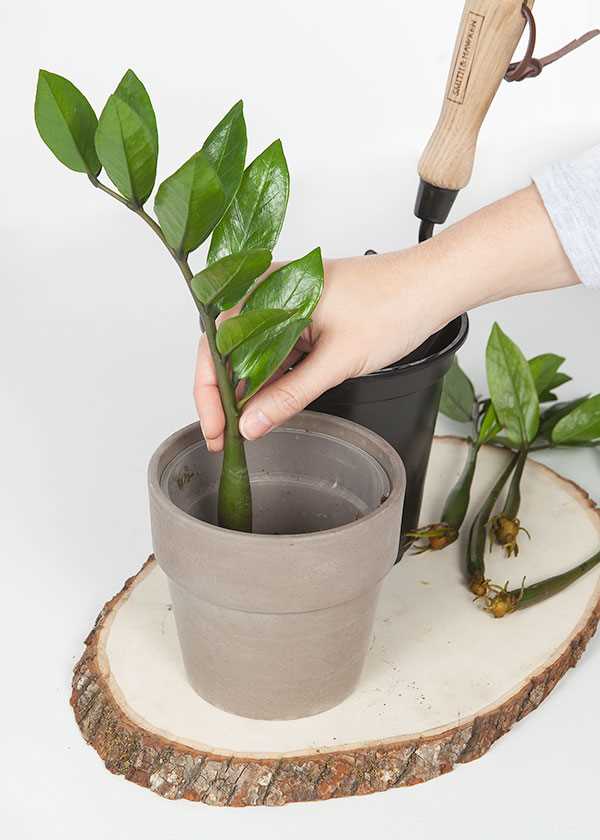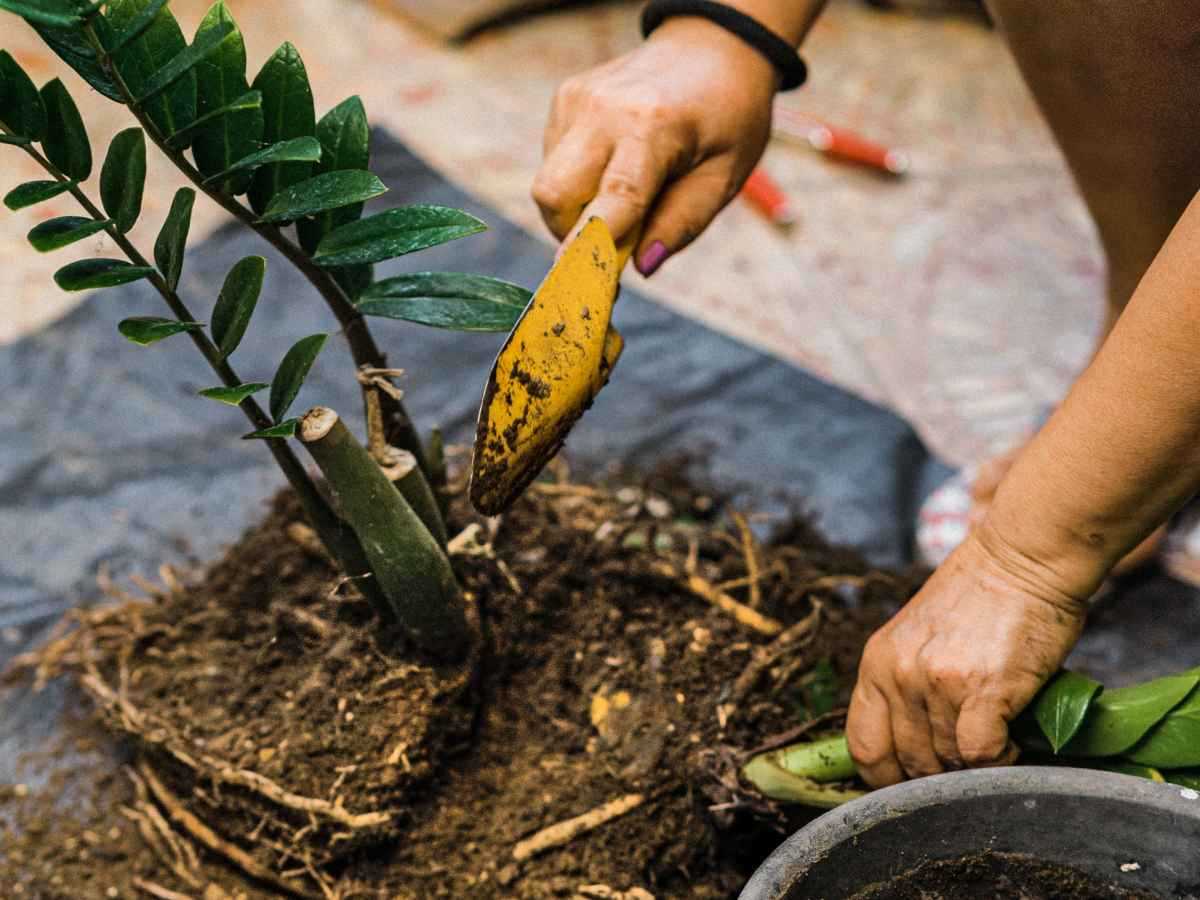- Choosing the Right Location for Your Zamioculcas
- Light
- Temperature
- Humidity
- Soil and Pot
- Air Circulation
- Essential Care Tips for Zamioculcas
- Light
- Watering
- Temperature and Humidity
- Soil and Fertilizer
- Pruning
- Pests and Diseases
- Watering and Moisture Requirements
- Fertilizing Your Zamioculcas: Dos and Don’ts
- Do:
- Don’t:
- Common Pests and Diseases: Prevention and Treatment
- Pests
- Diseases
- Propagating Zamioculcas: Step-by-Step Guide
- Repotting Zamioculcas: When and How to Transplant
- When to Repot
- How to Repot
- Aftercare
- Frequently Asked Questions about Zamioculcas
- 1. How often should I water my Zamioculcas plant?
- 2. Can I place my Zamioculcas plant in direct sunlight?
- 3. How often should I fertilize my Zamioculcas plant?
- 4. Can I propagate my Zamioculcas plant?
- 5. When should I transplant my Zamioculcas plant?
- Q&A:
- What are the basic care requirements for Zamioculcas?
- How often should I water my Zamioculcas?
- Can I place my Zamioculcas in direct sunlight?
- How can I propagate my Zamioculcas?
- When is the best time to transplant my Zamioculcas?
- What are some common problems that can affect Zamioculcas?
- Video: 3 EASY Ways To Propagate Your ZZ Plant!
Are you looking for a low-maintenance plant that will add a touch of greenery to your home or office? Look no further than the Zamioculcas, also known as the ZZ plant. This popular houseplant is known for its attractive, glossy leaves and its ability to thrive in a variety of environments. Whether you’re an experienced plant parent or a beginner, the Zamioculcas is a great choice.
The Zamioculcas is native to eastern Africa and is a member of the Araceae family. It is a slow-growing plant that can reach a height of about 2-3 feet, making it perfect for smaller spaces. Its thick, upright stems are topped with shiny, dark green leaves that arch gracefully, giving it a unique and elegant appearance.
One of the reasons why the Zamioculcas is so popular is because it is incredibly easy to care for. It can tolerate a wide range of light conditions, from bright indirect light to low light, making it ideal for any room in your home. It also has a high tolerance for neglect and can go several weeks without water, so it’s a great choice for busy plant owners or frequent travelers.
If you’re interested in propagating your Zamioculcas, you’ll be happy to know that it’s relatively simple. You can propagate it through division or by taking leaf cuttings. Both methods are effective and will result in new plants that are identical to the parent plant. Once you have your new plants, you can transplant them into larger pots to allow for continued growth.
Choosing the Right Location for Your Zamioculcas
When it comes to selecting a location for your Zamioculcas plant, it is important to consider its natural habitat and growing conditions. Zamioculcas is native to the dry regions of eastern Africa, where it thrives in hot and arid environments. Therefore, it is crucial to recreate these conditions as closely as possible in your home or garden.
Light
Zamioculcas prefers bright, indirect light, but it can also tolerate low light conditions. Avoid placing your plant in direct sunlight, as this can cause its leaves to scorch. A north or east-facing window is usually the best spot for your Zamioculcas. If you don’t have access to natural light, you can also use fluorescent lights to provide sufficient light for your plant.
Temperature
Zamioculcas is a tropical plant that prefers warm temperatures between 60°F and 80°F (15°C and 27°C). It is essential to keep it away from drafts and cold air, as exposure to low temperatures can harm the plant. Avoid placing it near doors, windows, or air conditioning vents.
Humidity
Zamioculcas can tolerate a wide range of humidity levels, but it thrives in average room humidity. If the air in your home or office is particularly dry, you can increase humidity by placing the pot on a tray filled with water and pebbles. Just make sure the bottom of the pot does not come into direct contact with the water, as this can lead to root rot.
Soil and Pot
Zamioculcas plants prefer well-draining soil to avoid waterlogged roots. A mixture of potting soil, perlite, and sand works well. Choose a pot with drainage holes to allow excess water to escape. The size of the pot should be appropriate for the size of the plant, with enough room for root growth.
Air Circulation
Ensuring adequate air circulation around your Zamioculcas plant is also essential for its health. Good air circulation helps prevent the development of fungal diseases and keeps the plant’s foliage dry. Avoid placing the plant in crowded areas or close to walls.
By carefully considering these factors, you can create the perfect environment for your Zamioculcas plant to thrive and grow into a beautiful and healthy specimen.
Essential Care Tips for Zamioculcas
Zamioculcas, also known as the ZZ plant, is a popular houseplant due to its low maintenance and ability to thrive in a variety of conditions. Here are some essential care tips to ensure the healthy growth of your Zamioculcas:
Light
- Zamioculcas can tolerate low light conditions but prefers bright, indirect light.
- Avoid placing the plant in direct sunlight as it can scorch the leaves.
- Rotate the plant every few months to ensure even growth.
Watering
- Zamioculcas has succulent-like leaves that store water, so it is drought-tolerant.
- Allow the soil to dry out partially between waterings.
- Overwatering can lead to root rot, so it is better to underwater than overwater.
- Water the plant deeply, allowing excess water to drain out of the pot.
Temperature and Humidity
- Zamioculcas can tolerate a wide range of temperatures, from 60°F (15°C) to 80°F (27°C).
- Avoid placing the plant in drafty areas or near heating vents.
- It can adapt to low humidity environments but appreciates higher humidity.
- Misting the leaves occasionally can help increase humidity.
Soil and Fertilizer
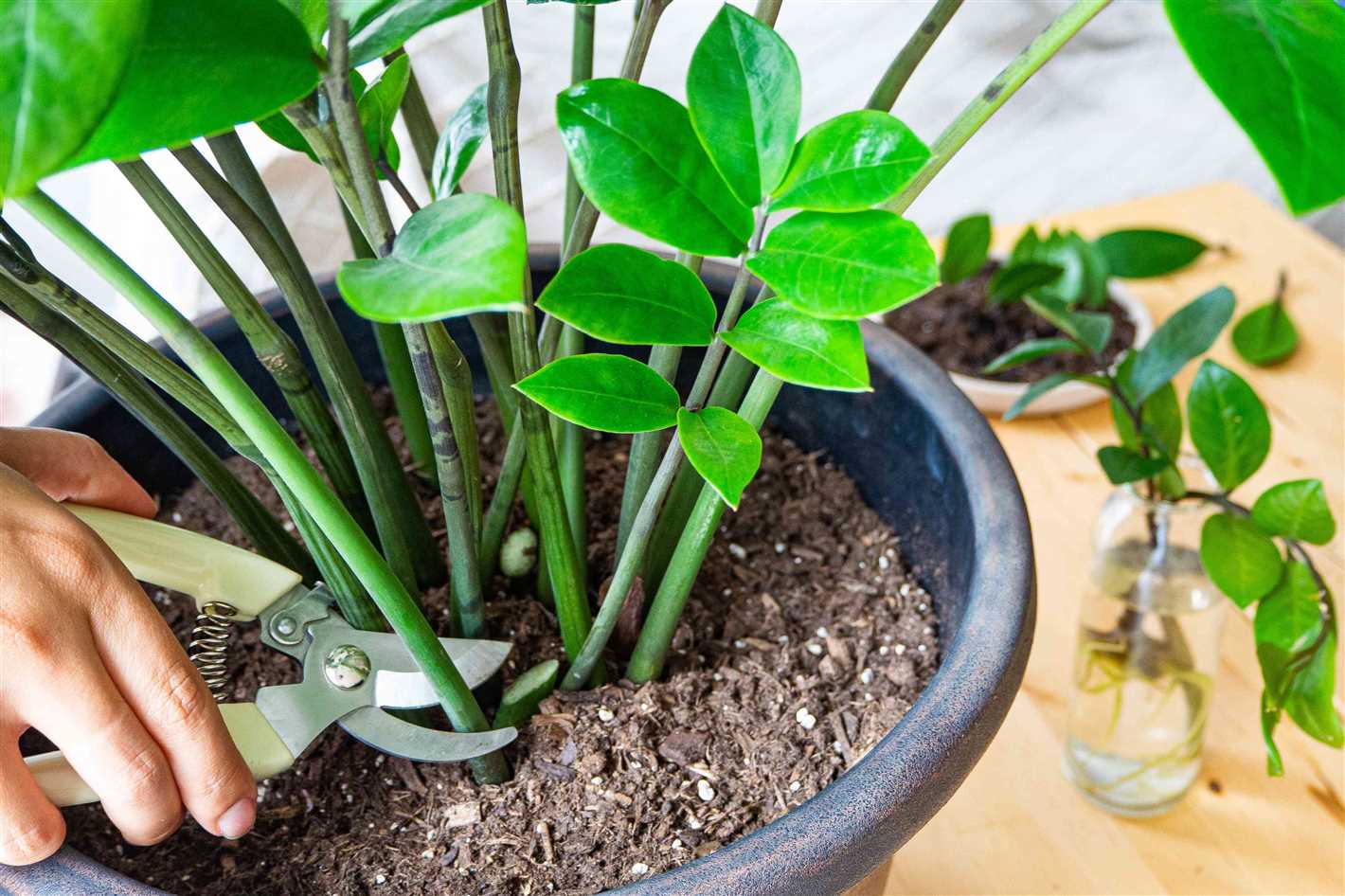
- Plant Zamioculcas in well-draining soil, such as a mix of potting soil, perlite, and sand.
- Use a balanced, water-soluble fertilizer diluted to half strength during the growing season (spring and summer).
- Avoid overfertilizing as it can lead to salt build-up in the soil.
Pruning
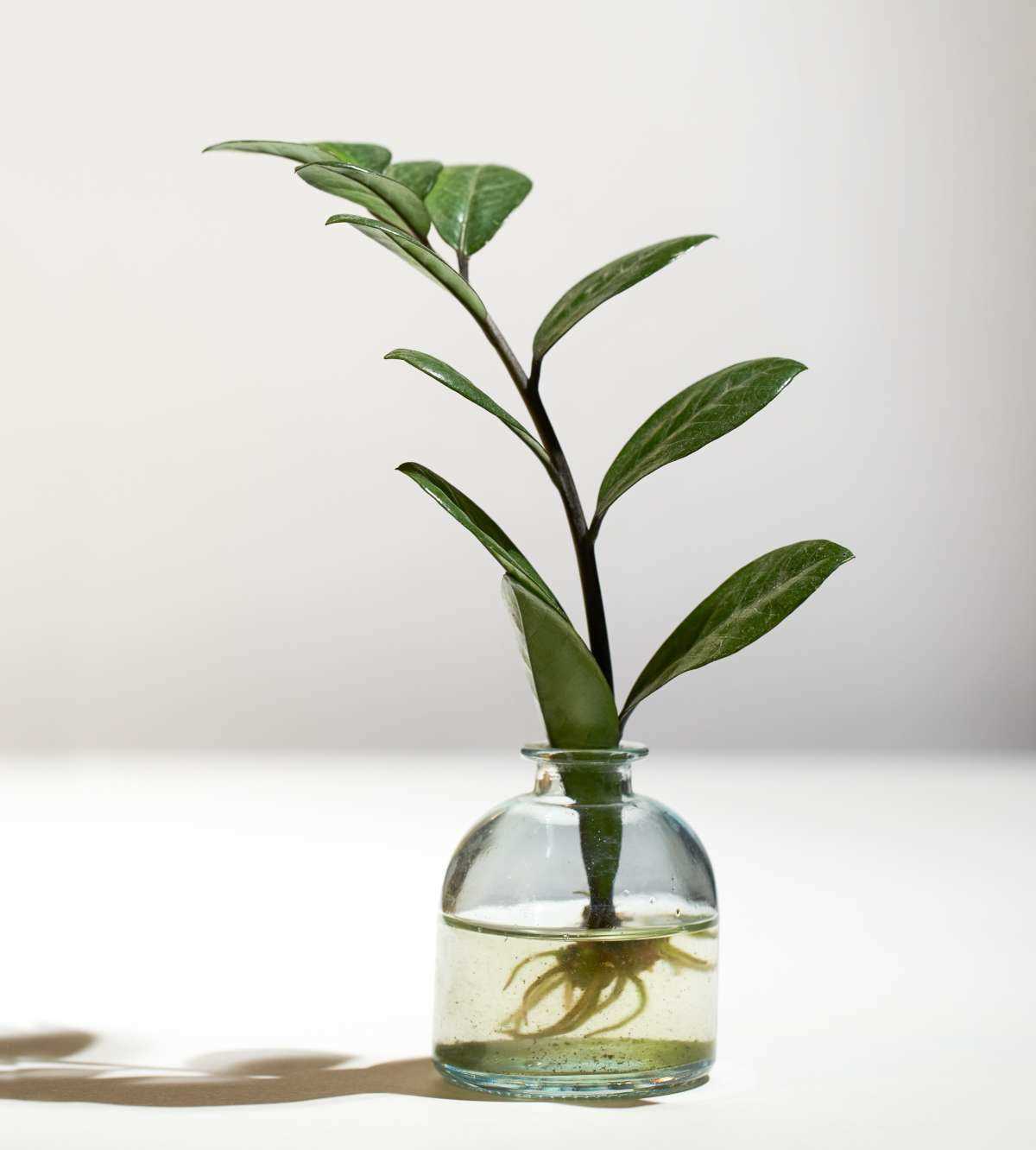
- Remove any yellow or dead leaves to maintain the plant’s appearance.
- Prune leggy stems to encourage bushier growth.
- Wear gloves when pruning as the sap of Zamioculcas can cause skin irritation.
Pests and Diseases
- Zamioculcas is generally pest and disease resistant.
- Keep an eye out for mealybugs, spider mites, and scale insects.
- If infested, treat the plant with a mild insecticidal soap or neem oil.
By following these essential care tips, you can enjoy a thriving and healthy Zamioculcas in your home or office space.
Watering and Moisture Requirements
Zamioculcas is a drought-tolerant plant, meaning that it can survive in low-water conditions. However, it is important to provide the plant with adequate moisture to ensure its growth and health.
The watering requirements of Zamioculcas depend on several factors such as the season, temperature, humidity, and the size of the plant. In general, it is recommended to water the plant thoroughly but infrequently. Let the soil dry out between waterings, and only water when the top inch of soil feels dry to the touch.
Overwatering can lead to root rot and other fungal diseases, so it is important to avoid keeping the soil constantly wet. Ensure good drainage by using a well-draining potting mix and a pot with drainage holes at the bottom.
In summer or warm weather, the plant may need more frequent watering. However, always check the moisture level of the soil before watering and adjust accordingly. If the soil feels excessively dry or if the leaves start to droop, it is an indication that the plant needs water.
On the other hand, in winter or cooler months, Zamioculcas goes into a period of dormancy and requires less water. Reduce the frequency of watering and allow more time for the soil to dry out.
It is also important to avoid spraying water on the leaves of Zamioculcas, as it can attract pests and lead to fungal diseases. Instead, water the plant at the base to keep the leaves dry.
Monitoring the moisture level of the soil and adjusting the watering accordingly is crucial in maintaining the health and well-being of your Zamioculcas plant.
Fertilizing Your Zamioculcas: Dos and Don’ts
Proper fertilization is essential for the healthy growth of your Zamioculcas plant. Here are some dos and don’ts to keep in mind when fertilizing your Zamioculcas:
Do:
- Use a balanced, water-soluble fertilizer designed for houseplants.
- Follow the instructions on the fertilizer packaging for the correct dilution ratio.
- Fertilize your Zamioculcas during the growing season, which is usually from spring to summer.
- Apply the fertilizer to moist soil to prevent burning the roots.
- Water your Zamioculcas after fertilizing to help distribute the nutrients evenly.
- Monitor the health of your plant and adjust the frequency of fertilization if needed.
Don’t:
- Over-fertilize your Zamioculcas, as this can lead to fertilizer burn and damage the plant.
- Use a fertilizer with a high nitrogen content, as this can result in excessive foliage growth at the expense of root development.
- Apply fertilizer during the dormant period, as the plant does not require additional nutrients during this time.
- Apply fertilizer to dry soil, as it can cause damage to the plant’s roots.
- Assume that more fertilizer is better – always follow the recommended dosage.
Remember, proper fertilization, along with adequate watering and lighting, will help your Zamioculcas thrive and maintain its vibrant green foliage.
Common Pests and Diseases: Prevention and Treatment
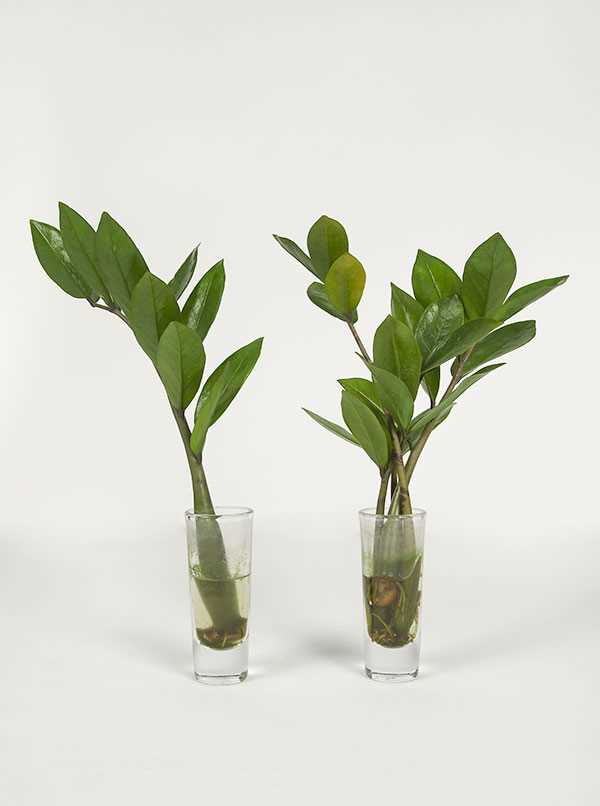
Like any houseplant, zamioculcas (ZZ plant) can be susceptible to certain pests and diseases. However, with proper care and maintenance, you can prevent these issues and treat any problems that may arise.
Pests
1. Spider mites: These tiny pests can appear as tiny red or brown spots on the leaves. They can cause the leaves to become yellow and eventually fall off. To prevent spider mites, regularly spray the plant with water and keep the humidity levels high. If an infestation occurs, wipe the leaves with a damp cloth or use an insecticidal soap to control the pests.
2. Mealybugs: Mealybugs are small, white, cotton-like pests that can be found in the crevices of the plant. They suck the sap from the leaves and, if left untreated, can cause the plant to weaken and die. To prevent mealybugs, inspect the plant regularly and isolate any infested plants. You can use alcohol-soaked cotton swabs to manually remove the pests or use insecticidal soap for severe infestations.
3. Scale insects: These pests resemble small bumps on the leaves and stems, and they can cause the plant to weaken and become stunted. Prevention is key, so regularly inspect the plant for any signs of scale insects and remove them manually with a cotton swab dipped in rubbing alcohol. You can also use horticultural oil spray to control the infestation.
Diseases
1. Root rot: Overwatering can lead to root rot, which is a fungal disease that affects the roots of the ZZ plant. To prevent root rot, ensure that the plant is placed in well-draining soil and that you allow the top inch of soil to dry out before watering again. If root rot occurs, remove the affected parts of the plant and repot it in fresh, well-draining soil.
2. Leaf spots: Leaf spots can be caused by fungal or bacterial infections and appear as dark or discolored spots on the leaves. To prevent leaf spots, avoid getting the leaves wet while watering and ensure good air circulation around the plant. If leaf spots occur, remove the affected leaves and apply a fungicide or bactericide to prevent further spread.
3. Edema: Edema is a condition that occurs when the plant absorbs more water than it can transpire, causing swollen and blister-like patches on the leaves. To prevent edema, avoid overwatering and provide adequate drainage for the plant. If edema occurs, reduce watering and increase air circulation around the plant.
Remember, regular inspection, proper watering, and maintaining a healthy environment for your zamioculcas can greatly reduce the risk of pests and diseases. With a little bit of care, your ZZ plant will thrive and remain vibrant for years to come.
Propagating Zamioculcas: Step-by-Step Guide
Propagating zamioculcas is a great way to expand your collection or share the plant with friends and family. Here is a step-by-step guide to propagate zamioculcas:
- Choose a healthy mother plant: Select a mature and healthy zamioculcas plant for propagation. Look for a plant with multiple stems and well-developed roots.
- Gather necessary materials: Prepare a clean pair of pruning shears, a sharp knife, and a pot with well-draining soil. It’s also helpful to have some rooting hormone powder on hand.
- Take stem or leaf cuttings: You have two options for propagation – stem cuttings or leaf cuttings. For stem cuttings, use the pruning shears to cut a healthy stem from the mother plant. Make sure the cutting is at least 6 inches long and has a few leaves attached. For leaf cuttings, gently remove a leaf from the mother plant, making sure to include a small portion of the stem.
- Apply rooting hormone (optional): If you have rooting hormone powder, dip the cut end of the stem or leaf in the powder before planting. This will help stimulate root growth.
- Plant the cuttings: Fill a pot with well-draining soil and create a small hole. Insert the stem or leaf cutting into the hole, making sure it is securely in place. For stem cuttings, bury about half of the cutting in the soil, ensuring that at least one leaf is above the soil surface.
- Provide proper care: Place the pot in a bright and warm location, but away from direct sunlight. Water the cuttings sparingly, allowing the soil to dry out slightly between waterings. Avoid overwatering, as this can lead to root rot.
- Monitor and wait for roots: Check on the cuttings regularly and look for signs of new growth. Roots should start to develop within a few weeks to a couple of months, depending on the propagation method used.
- Transplant the new plants: Once the cuttings have developed a healthy root system, they can be transplanted into their own pots. Use a well-draining soil mix and gently transfer the new plants, making sure to keep the soil level at the same depth as before.
- Continue care: After transplanting, continue to provide the new zamioculcas plants with proper care, including regular watering, adequate sunlight, and occasional fertilization.
By following these steps, you can successfully propagate zamioculcas and enjoy the beauty of this resilient plant in multiple locations.
Repotting Zamioculcas: When and How to Transplant
Repotting is an important part of caring for your Zamioculcas plant. It allows the plant to grow and thrive by providing fresh nutrients and space for the roots to expand. Knowing when and how to transplant your Zamioculcas will ensure its continued health and vitality.
When to Repot
There are a few signs that indicate it’s time to repot your Zamioculcas:
- If the plant is visibly root-bound, meaning the roots are tightly packed in the pot and beginning to circle around the bottom
- If the plant is top-heavy and tips over easily
- If the plant has stopped growing or has become stunted
It’s generally recommended to repot your Zamioculcas every 2-3 years, or when you notice any of these signs.
How to Repot
Follow these steps to successfully transplant your Zamioculcas:
- Choose a slightly larger pot with drainage holes to prevent waterlogging.
- Prepare a well-draining potting mix, such as a mixture of perlite, sand, and regular potting soil.
- Carefully remove the Zamioculcas from its current pot, gently loosening the roots if they’re tightly packed.
- Inspect the roots for any signs of rot or damage, and trim as necessary.
- Place a layer of the potting mix at the bottom of the new pot.
- Position the Zamioculcas in the new pot, making sure it’s centered.
- Fill in the remaining space around the roots with the potting mix, gently pressing down as you go.
- Water the newly transplanted Zamioculcas thoroughly, allowing the excess water to drain through the holes.
Aftercare
After repotting, it’s important to provide proper aftercare for your Zamioculcas:
- Place the newly repotted plant in a spot with bright, indirect light.
- Avoid direct sunlight, as it can scorch the leaves.
- Water the plant only when the top few inches of soil are dry, as overwatering can lead to root rot.
- Monitor the plant closely for the first few weeks after repotting to ensure it is adjusting well.
By following these guidelines, you can successfully repot your Zamioculcas and provide it with the care it needs to continue thriving.
Frequently Asked Questions about Zamioculcas
1. How often should I water my Zamioculcas plant?

Zamioculcas plants are drought-tolerant, meaning they can survive in low moisture conditions. It is recommended to water them every 2-3 weeks during the growing season (spring and summer) and every 4-6 weeks during the dormant period (fall and winter). However, make sure not to overwater them as it can lead to root rot.
2. Can I place my Zamioculcas plant in direct sunlight?
Zamioculcas plants prefer bright, indirect light. While they can tolerate some direct sunlight, it is best to avoid placing them in intense, full sun as it can scorch the leaves. Place them in a location with filtered or partial sunlight for optimal growth.
3. How often should I fertilize my Zamioculcas plant?
Zamioculcas plants do not require frequent fertilization. It is sufficient to fertilize them once every 2-3 months during the growing season with a balanced houseplant fertilizer. Avoid overfertilization as it can result in leaf burn.
4. Can I propagate my Zamioculcas plant?
Yes, Zamioculcas plants can be propagated through stem cuttings or by dividing the rhizomes. To propagate through stem cuttings, select a healthy stem with several leaflets and root it in well-draining soil. For division, carefully separate the plant into sections, making sure each section has roots and stems. Plant them in separate pots with fresh potting mix.
5. When should I transplant my Zamioculcas plant?

Zamioculcas plants prefer to be slightly pot-bound, so it is recommended to transplant them only when necessary. Signs that indicate the need for repotting include roots coming out of the drainage holes, excessive root growth, or the plant becoming too heavy for its current pot. Spring is the best time to transplant Zamioculcas plants as they enter their active growth phase.
Q&A:
What are the basic care requirements for Zamioculcas?
Zamioculcas requires bright, indirect light, well-draining soil, and infrequent watering. They can tolerate low light conditions and can go without water for long periods, making them fairly low-maintenance plants.
How often should I water my Zamioculcas?
Zamioculcas should be watered sparingly, allowing the soil to dry out between waterings. It is better to underwater than overwater, as Zamioculcas can rot if the soil is too wet.
Can I place my Zamioculcas in direct sunlight?
Zamioculcas can tolerate some direct sunlight, but prolonged exposure to intense sunlight can scorch its leaves. It is best to place them in bright, indirect light or in a spot with filtered light.
How can I propagate my Zamioculcas?
Zamioculcas can be propagated by dividing the plant at the rhizome level. Carefully separate the rhizomes and plant them in separate pots with well-draining soil. Keep the new plants in a warm and humid environment, misting them regularly.
When is the best time to transplant my Zamioculcas?
The best time to transplant Zamioculcas is in the spring or early summer when the plant is actively growing. Choose a pot that is slightly larger than the current one and use well-draining soil to prevent waterlogging.
What are some common problems that can affect Zamioculcas?
Some common problems that can affect Zamioculcas are overwatering, which can lead to root rot, and too much direct sunlight, which can cause leaf burn. Spider mites and mealybugs are also common pests that can infest Zamioculcas. However, by providing the right care and ensuring proper growing conditions, these problems can be easily avoided.
Video:
3 EASY Ways To Propagate Your ZZ Plant!
